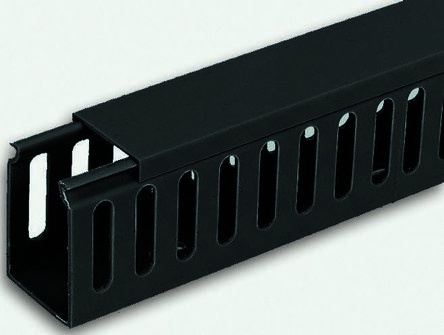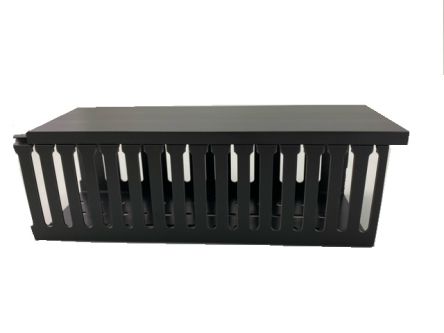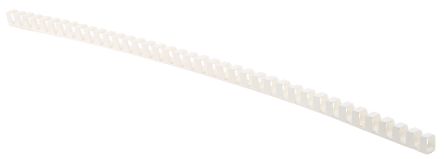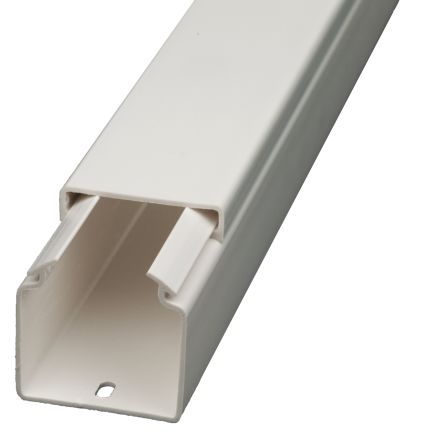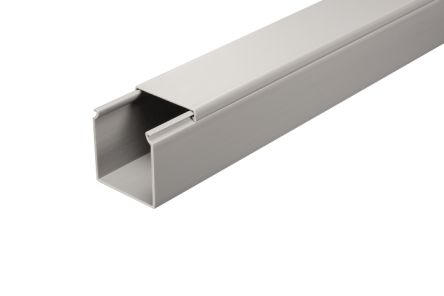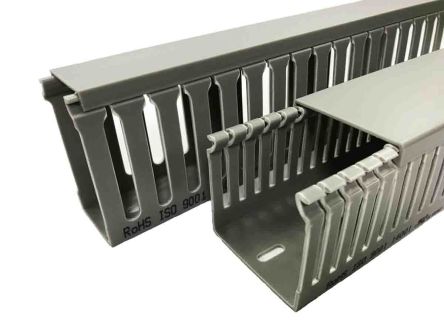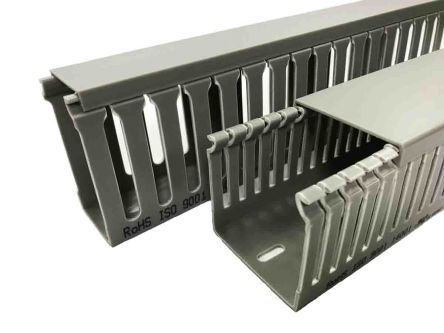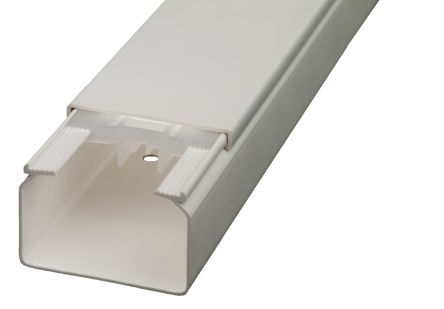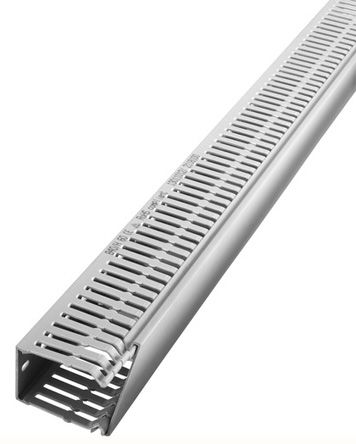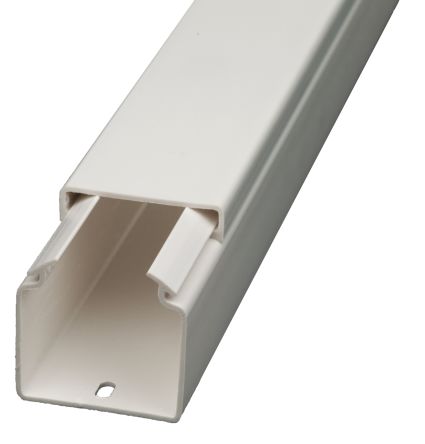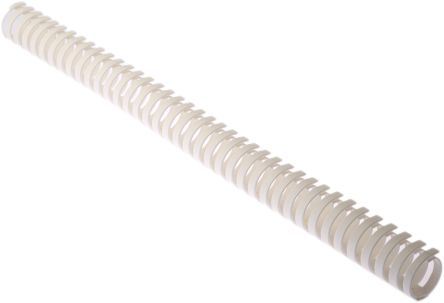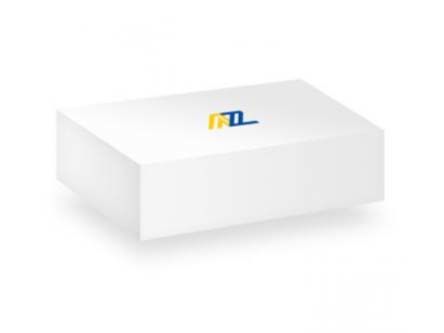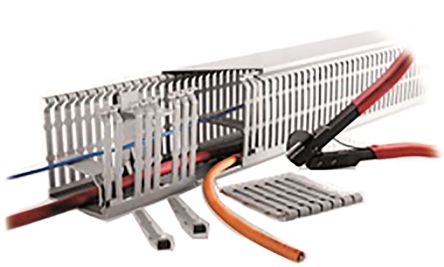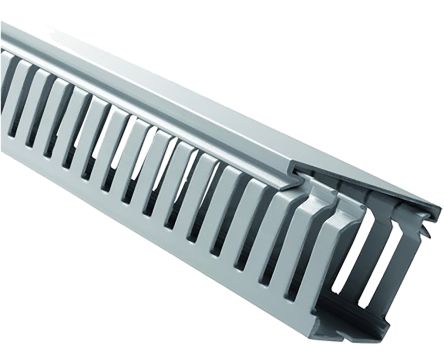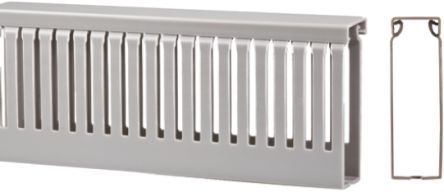- Automation & Control Gear
- Cables & Wires
- Enclosures & Server Racks
- Fuses & Circuit Breakers
- HVAC, Fans & Thermal Management
- Lighting
- Relays & Signal Conditioning
- Switches
- Batteries & Chargers
- Connectors
- Displays & Optoelectronics
- ESD Control, Cleanroom & PCB Prototyping
- Passive Components
- Power Supplies & Transformers
- Raspberry Pi, Arduino, ROCK, STEM Education & Development Tools
- Semiconductors
Cable Trunking
Cable trunking is a system used to organise and protect electrical cables or wires in buildings or industrial settings. It provides a safe and tidy way to route and conceal cables, improving the overall appearance and safety of the installation. Cable trunking or slotted trunking typically consists of a rectangular or square-shaped enclosure made of plastic, rubber, aluminium or other metals. The enclosure has a removable or hinged cover, allowing easy access to the cables when necessary. The trunking is designed with various compartments or channels to accommodate multiple wires or cables of different types and sizes.
Types of Cable Trunking
Cable trunking comes in various types, each designed to meet specific needs for organising and protecting electrical cables in different environments across NZ. Here are some of the common types:
PVC Cable Trunking
PVC cable trunking is the most commonly used type, known for its affordability and ease of installation. Made from polyvinyl chloride (PVC), this material is lightweight and versatile, available in various sizes, shapes, and colours to suit different cable management needs. Its non-conductive properties make it ideal for general-purpose wiring in residential, commercial, and industrial applications where it is used as a cost-effective option for electrical trunking, wire trunking or conduit trunking.
Metal Cable Trunking
Metal cable trunking, often made from steel or aluminium, offers superior durability and protection against physical damage, such as impacts or crushing. This type of cable trunking is especially suited for industrial environments or areas with higher mechanical stress, where robust protection and fire resistance are critical. Aluminium cable trunking is particularly valued for its lightweight yet strong construction, making it ideal for demanding applications across NZ where a light material is preferred.
Adhesive Cable Trunking
Adhesive cable trunking, also known as self-adhesive trunking, simplifies installation with a pre-applied adhesive strip on the back. This type of cable trunking can be easily attached to walls, ceilings, or other surfaces without the need for drilling or additional fixings, making it ideal for settings where a clean, non-invasive installation is preferred. It's commonly used in residential or commercial spaces where quick and easy cable management is needed.
Flexible Cable Trunking
Flexible cable trunking is designed to accommodate cables that need to be routed around corners or through confined spaces. Typically made of plastic or rubber, this type of wire trunking is ideal for managing cables in complex installations. Its coiled or spiral design allows it to expand and contract as needed, providing a versatile solution for dynamic and tight spaces, ensuring your cables are well-protected while maintaining flexibility.
Advantages of Cable Trunking
From slotted trunking to electrical trunking, wire trunking and more, cable trunking is essential for enhancing safety and aesthetics across residential, commercial and industrial environments in NZ.
Cable Protection
Cable trunking shields cables from physical damage, such as impact, crushing, or accidental contact with sharp objects, which could potentially cause short circuits, electric shocks, or fires.
Cable Organisation
Slotted trunking helps to keep cables organised and prevents them from becoming tangled or snarled, making it easier to identify and manage individual cables during installation, maintenance, or repairs.
Safety and Aesthetics
Concealing cables within trunking can hide trip hazards and improve the overall appearance of the space. It also prevents dust accumulation on the cables, which can be a fire hazard.
**Electromagnetic Interference (EMI) Protection **
Some types of cable trunking are designed with features like metal shielding or grounding capabilities, which help to reduce electromagnetic interference or electromagnetic radiation emitted by the cables.
Applications of Cable Trunking
Cable trunking is widely used across various fields to ensure organised, safe, and efficient management of electrical and other types of cables. Its versatility makes it a crucial component in both residential and industrial settings in NZ.
Commercial Buildings
In commercial buildings, cable trunking is essential for managing the extensive network of power and data cables. It keeps cables neatly organised, reducing clutter and improving accessibility for maintenance and upgrades.
Industrial Facilities
Electrical trunking in industrial facilities provides robust protection for cables running through harsh environments. It safeguards cables from physical damage, chemical exposure, and other industrial hazards, ensuring the reliable operation of machinery and equipment.
Residential Installations
Wire trunking is commonly used in residential settings to conceal and protect cables along walls and ceilings. It enhances the aesthetics of living spaces while reducing the risk of accidents such as tripping over loose wires.
Data Centers
In data centres, slotted trunking is often used to manage large volumes of network cables. It ensures efficient routing and organisation of cables, which is critical for maintaining optimal performance and minimising downtime.
Healthcare Facilities
Cable trunking in healthcare facilities is vital for safely managing cables connected to medical equipment. It prevents cables from becoming tangled or damaged, which is crucial for the continuous operation of life-saving devices.
**Educational Institutions **
In schools and universities, conduit trunking is used to protect and organise cables in classrooms, laboratories, and auditoriums. It ensures a safe learning environment by keeping cables out of the way and preventing accidental damage.
Explore Quality Cable Trunking Solutions Today!
RS is your trusted supplier and distributor of high-quality cable trunking solutions in NZ. Whether you need electrical trunking, slotted trunking, conduit trunking, wire trunking, or more, our extensive range includes top brands like Beta Duct, Igus, and HellermannTyton, ensuring you find the perfect product for your cable management needs. Explore our selection today and enhance the safety and aesthetics of your environment with reliable cable trunking solutions.
Ordering & Delivery Information for NZ
RS provides reliable and timely delivery of cable trunking and other cable management products such as cable grommets or cable covers. To learn more about our delivery services, estimated timeframes, and costs, please visit our Delivery Information page.

